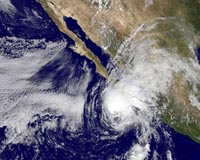| . |  |
. |
Suva (AFP) March 15, 2010 Fiji's main centres were put under curfew overnight as the South Pacific nation braced for a powerful cyclone expected to pass over the north and east of the country, officials said Monday. Cyclone Tomas was located about 185 kilometres (115 miles) northeast of the town of Labasa on the northern island of Vanua Levu at 7:00 am (1800 Sunday GMT). "Fiji has not faced a cyclone this strong lately, and we are not taking this thing lightly," Fiji Disaster Management Office director Pajiliai Dobui told Radio New Zealand. There were reports of power cuts on Vanua Levu and damage to houses on outlying islands as the cyclone approached. The category four cyclone, the second most powerful on a five point scale, was estimated to have average winds of 170 kilometres an hour, and was expected to intensify to 205 kilometres an hour over the next 12 to 24 hours, the Fiji Meteorological Service (FMS) said. The cyclone was moving south at 11 kilometres an hour and was expected to be centred about 60 kilometres east of Labasa by evening, the FMS said. The government declared an overnight curfew but this was lifted in most areas Monday morning to allow people to stock up on emergency supplies. Schools were closed and most public services suspended as the country prepared for strong winds and flooding.
earlier related report French-speaking meteorologists based in Martinique will provide briefings, while Cuba and Jamaica will be asked to send satellite radar imagery, hurricane experts said at the close of a five-day conference in Bermuda. Several other countries offered storm tracking and communications equipment as well as personnel to rebuild the quake-ravaged island's forecasting capability. The January 12 earthquake left at least 220,000 people dead and more than one million homeless, living in tents or makeshift shelters that make them especially vulnerable to even minor storms. Experts hope to have a weather service in place by April when the rainy season begins. Ronald Semelfort, director of Haiti's Met Service, said most of the camps that have sprung up across the capital could not resist even 10 millimeters (0.3 inches) of rainfall. "There are a good many people living in dangerous shelters, in tents -- these people are out in the open. They are extremely vulnerable to wind and rain," he said. Jean Noel Degrace, of Meteo France, headed up the task force on Haiti at this week's conference. If a hurricane struck the impoverished Caribbean country this year, it would be devastating, he said. "Two weeks ago, there was flooding from a cold front. It was a very low amount of rain, but 18 or 20 more people were killed. You can only imagine what a hurricane would do," said Degrace. He said the immediate priority was to provide Haiti with the necessary technology and expertise to predict storms. "It is really urgent to ensure Haiti gets really good watches and warnings" of storm activity, as well as the ability to run a daily forecasting service with proper facilities and communications, he said. "We would like to be sure that they are able to access data on observations and forecasts, radar imagery, charts, watches and warnings." With 80 percent of the population without access to television or radio, communicating forecasts to the public is also a major concern. Bill Read, head of the Miami-based National Hurricane Center, said Haiti is "going to have the challenge of warning the people that a storm is coming. We don't know where their infrastructure is going to be by then, so that is up in the air."
Share This Article With Planet Earth
Related Links Bringing Order To A World Of Disasters When the Earth Quakes A world of storm and tempest
 Tropical storms to be more intense but less frequent: climate study
Tropical storms to be more intense but less frequent: climate studyParis (AFP) Feb 21, 2010 Tropical cyclones may become less frequent this century but pack a stronger punch as a result of global warming, a paper published on Sunday said. The study is an overview of work into one of the scariest yet also one of the least understood aspects of climate change. Known in the Atlantic as hurricanes and in eastern Asia as typhoons, tropical storms are driven by the raw fuel of warm s ... read more |
|
| The content herein, unless otherwise known to be public domain, are Copyright 1995-2010 - SpaceDaily. AFP and UPI Wire Stories are copyright Agence France-Presse and United Press International. ESA Portal Reports are copyright European Space Agency. All NASA sourced material is public domain. Additional copyrights may apply in whole or part to other bona fide parties. Advertising does not imply endorsement,agreement or approval of any opinions, statements or information provided by SpaceDaily on any Web page published or hosted by SpaceDaily. Privacy Statement |